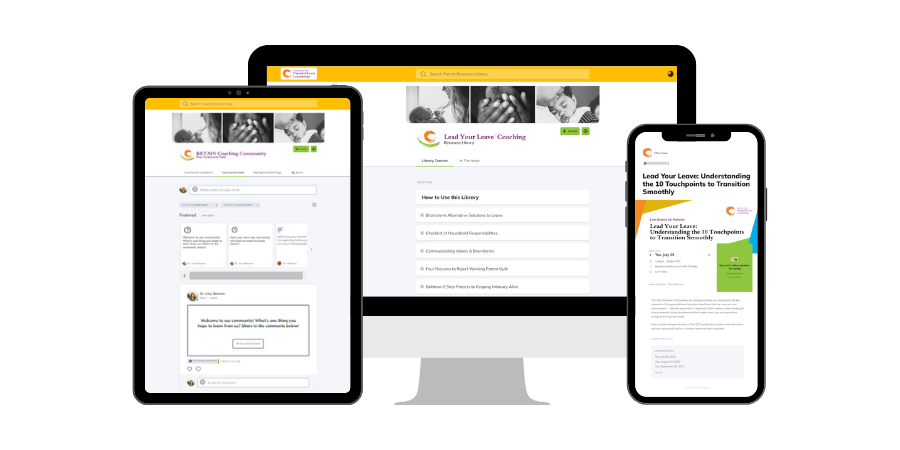Parental Leave Policies Can’t Repair a Broken System Alone
How to Improve Company Culture with Parental Leave Practice

Essential Takeaways:
- A Broken System: Companies are unfairly expected to do the work of society. Despite years of advocacy, a vast majority of U.S. employees still lack access to paid parental leave, with low-wage workers, particularly women and people of color, being the most vulnerable. Additionally, very few managers and expecting/new parents receive any type of leave resources or navigation support, let alone socio-emotional transition support.
- The Hidden Costs: Beyond the immediate and longer-term financial impact on families, the lack of comprehensive parental leave policy and strategic planning affects key metrics, including company productivity, employee morale, retention, overall profits, and positioning–the cost to our national GDP is only recently being considered and calculated.
- Policy Isn’t Enough: While establishing paid leave policies is crucial, genuine solutions require thoughtful, strategic, human-centered support and effective implementation.
- Workplace Culture: For the foreseeable future, companies will be expected to transform their corporate workplace cultures to support this critical career passage. When this challenge is taken up as the opportunity it is, employers can pave the way for enduring, embedded solutions throughout their organizations, with positive ripples extending out and improving the fabric of our society.
There is a hard truth in the United States that we can’t ignore: we are failing employees and employers due to inadequate and underwhelming national policies and nearly zero understanding of what constitutes effective parental leave practice. When I started writing The Parental Leave Playbook in 2020, in the midst of a world-changing pandemic, the vast majority of the people in the United States did not have access to paid parental leave. Sadly, in the past few years, that reality hasn’t changed as much as it needs to–even though demand and awareness have increased–and we have seen many more states either enact or work towards state paid leave policies.
As per the Department of Labor‘s data from March 2022, only 24% of private sector workers had access to paid family and medical leave through their employers, while 43% had access to short-term disability (SDI) through their employment. That means 57% of private sector workers had no access to either paid family and medical leave or State Disability Insurance (SDI).
Even more concerning, low-wage employees, a demographic where women and workers of color are overrepresented, are left particularly vulnerable. A staggering 98% of these workers have no leave access at all, and 89% don’t have access to short-term disability leave. This forces countless employees to leave their employer for another or be pushed out of the workforce altogether.
Contrary to common belief, the Family and Medical Leave Act (FMLA) does not offer paid leave. In fact, FMLA only assures unpaid job protection for a specified period to folks who meet certain requirements. Shockingly, an estimated 44% of the workforce is ineligible for FMLA benefits, leaving them without job protection or pay, depending on their state or employer.
In some fortunate cases, a new parent may receive paid leave through a state or local law or from an employer who voluntarily provides paid leave. This growing trend, particularly among large companies, is a glimmer of hope. Yet, for most new parents in the US, their reality is that welcoming a child also means bracing for a serious financial impact.
“It’s no accident that globally, parental leave is recognized as a societal issue necessitating a national solution, not an individual problem requiring an individual solution.“
The Ripple Effects of a Failing Parental Leave System
The ripple effects of failing to support working parents with robust policies and practices are extensive. Too often, we overlook the gravity of these consequences, accepting them as “just the way things are,” the norm. However, it’s crucial for employers to understand the far-reaching impacts of this systemic failure to adequately support this critical juncture in a working parents’ lifecycle.
- Working Families bear the brunt, with most parents losing wages while staying home to give birth or bond with a new child. This stress is compounded by high healthcare costs and inadequate health insurance, high risks of mental health challenges, hefty costs for infant child care, and countless other hardships that make it that much more difficult to adjust to parenthood–and return to work able to be focused and productive. We no longer live in a country where becoming a parent is financially or practically feasible for too many.
- Managers face significant challenges when their team members prepare to welcome a new child. Without clear policies and training on effective and developmental practices, communication often breaks down, morale dips, teams are overworked and frustrated, and ultimately, employees quit.
- Companies are expected to shoulder societal burdens that should be solved at the federal level simply because they are uniquely positioned to both solve and benefit from providing a solution to this systemic problem. A supportive workplace culture, appropriate parental leave policies, and trained and empathetic leadership can transform the parental leave experience for all stakeholders.
Although the United States needs more comprehensive data on the benefits of paid parental leave policies, the experiences of progressive organizations and other countries reveal that providing generous paid leave and supportive practices yields significant benefits. These benefits include healthier children and parents, strengthened work and family relationships, positive impacts on gender equity, and more inclusive work environments for all types of families.
A 2023 study out of Appalachian State University, authored by Dr. H. Kristl Davison, an Assistant Professor of Management, and Adam Scott Blackburn, an Organization Development Analyst in the healthcare industry, emphasizes that “a company’s bottom line may be further enhanced through paid leave’s association with increased productivity and morale, greater job satisfaction, and lower job turnover.”
“While paid leave is a step in the right direction, genuine, thoughtful, human-centered support is the cornerstone of an effective solution.“
Your Workforce Deserves a Better Parental Leave Experience
Leading a company is not an easy task. In the US, the default thinking is that companies should address this issue on their own with company-level solutions–because why not? They’re at the forefront of the issue with the ability to directly impact employees with better in-house policies using their own revenue dollars. However, this type of oppositional and dualistic thinking is a setup that keeps employers and employees stuck without the win-win solutions we know can exist. It’s no accident that globally, parental leave is recognized as a societal issue necessitating a national solution, not an individual problem requiring an individual solution.
The reality is, we are far from adopting the parental leave policies that the rest of the world has found to work well. This leaves the United States in an era of “both/and.” We need to address our immediate challenges (e.g., retention issues, financial hits, negative employee experience, compliance confusion, multi-state and remote employment complications, etc.) while also pushing for long-term systemic solutions at the federal level. Policy and practice are two sides of the same coin.
Over the last 5-10 years, visionary leaders have realized that supporting new parents with thorough and thoughtful parental leave policies and creating a holistic practice is a sound investment. The Society for Human Resource Management reports that replacing an employee can cost as much as 50-60% of their annual salary, while total associated costs of turnover can range from 90% to 200% of an employee’s annual salary.
Research also shows that well-rested and healthy parents are not only more productive and innovative, but they also have fewer accidents and insurance claims. As a bonus, their loyalty to their companies increases and enhances both retention and attraction. While paid leave is a step in the right direction, genuine, thoughtful, human-centered support is the cornerstone of an effective solution.
Most employers are beginning to realize that policy isn’t the magic bullet. True success hinges on its effective implementation. The key is to equip managers with the right tools and training, provide expecting and new parents unwavering support coupled with evidence-based assessments and resources, and foster a family-friendly workplace culture. When work environments evolve to prioritize working families, enduring and profitable solutions emerge.
A Path Torwards Enduring Solutions
Our journey at the Center for Parental Leave Leadership has revealed a treasure trove of solutions shaped by a decade of working with diverse companies. Whether you’re a budding startup, an established global corporation, or anything in between, we’re here to assist. From policy creation and strategic research to hands-on training, coaching, and support for individual employees, we’ve got you covered.
Together, let’s champion and create an environment that truly understands and honors the parental leave transition as a profound developmental opportunity lasting roughly a year for all stakeholders–at home and at work.

Did you enjoy this article?
Sign up for our free community inside our RETAIN Parental Leave Coaching Hub to access even more educational resources, community events, and our village of support created for anyone impacted by parental leave and its ripple effects.
Sources
Research is the bedrock of our mission and actions at the Center for Parental Leave Leadership. We wholeheartedly believe that informed decisions lead to transformative outcomes, and that’s why we place such a high value on research and data. Our commitment is unwavering: to rely exclusively on credible and respected sources in every facet of our work. Below are the trusted sources referenced in this article, reinforcing our dedication to evidence-based insights and practices.
- Paid Leave. (n.d.). DOL. https://www.dol.gov/agencies/wb/featured-paid-leave
- Morgan Stanley’s Chief Medical Officer Explains The Company’s Decision to Offer Enhanced Care Benefits: “It’s Part of Long-Term Thinking” — JUST Capital. (n.d.). JUST Capital. https://justcapital.com/news/morgan-stanley-paid-parental-leave-policy-care-benefits-2023/
- Beacom, A., Pytlovany, A., Campbell, S. (2021). Best practices for supporting the parental leave transition. The Journal of Total Rewards, 30(4), 18-35. https://worldatwork.org/resources/publications/journal/journal-of-total-rewards-q4-2021
- Tefft, B.C. (2016). Acute Sleep Deprivation and Risk of Motor Vehicle Crash Involvement (Technical Report). Washington, D.C.: AAA Foundation for Traffic Safety. https://aaafoundation.org/acute-sleep-deprivation-risk-motor-vehicle-crash-involvement/
- Davison HK, Blackburn AS. The Case for Offering Paid Leave: Benefits to the Employer, Employee, and Society. Compens Benefits Rev. 2023 Jan;55(1):3–18. doi: 10.1177/08863687221131728. PMCID: PMC9535467.
- Allen, D. G. (2008). Retaining talent: A guide to analyzing and managing employee turnover. Society for Human Resource Management. https://www.shrm.org/hr-today/trends-and-forecasting/special-reports-and-expert-views/Documents/Retaining-Talent.pdf
- Brown, S., Herr, J., Roy, R., & Klerman, J. A. (2020, July). Employee and Worksite Perspectives of the Family and Medical Leave Act: Supplemental Results from the 2018 Surveys (p. 20). Retrieved 23 January 2023, from Department of Labor website: https://www.dol.gov/sites/dolgov/files/OASP/evaluation/pdf/WHD_FMLA2018SurveyResults_Appendices_Aug2020.pdf
- Pew Research Center. (2023, May 9). Key facts about moms in the U.S. for Mother’s Day | Pew Research CenterKey facts about moms in the U.S. for Mother’s Day. https://www.pewresearch.org/short-reads/2023/05/09/facts-about-u-s-mothers/
- A fresh look at paternity leave: Why the benefits extend beyond the personal. (2021, March 5). McKinsey & Company. https://www.mckinsey.com/capabilities/people-and-organizational-performance/our-insights/a-fresh-look-at-paternity-leave-why-the-benefits-extend-beyond-the-personal
About the Center for Parental Leave Leadership
Navigating the journey of parenthood while balancing a career has its share of beautiful moments and inevitable challenges. At the Center for Parental Leave Leadership, we’ve walked this path alongside countless families, and we understand the nuances, joys, and anxieties it brings. Rooted in 35 years of dedicated research, our RETAIN Parental Leave Coaching™ method is more than just a framework—it’s a labor of love.
We’re here to support, guide, and empower employers, managers, and parents to turn the transition of parental leave into a shared journey of growth, empathy, and connection. Because everyone deserves to experience this profound life transition with support, clarity, and grace. Click here to learn more about what we do and set up a free informational call. Let’s dive deeper and chat about how we can help you.



